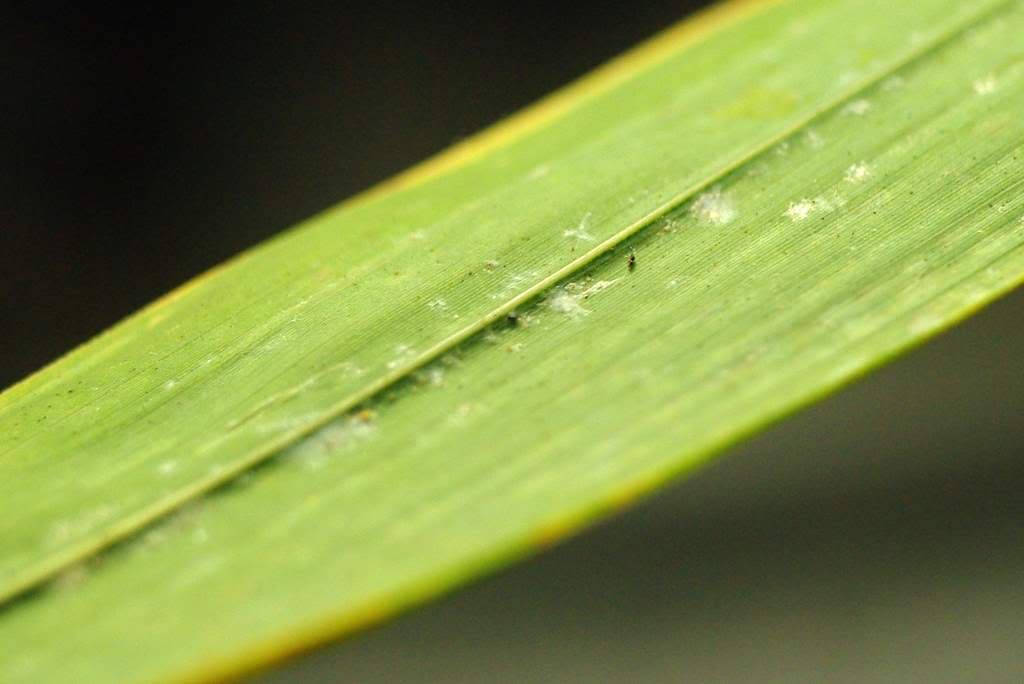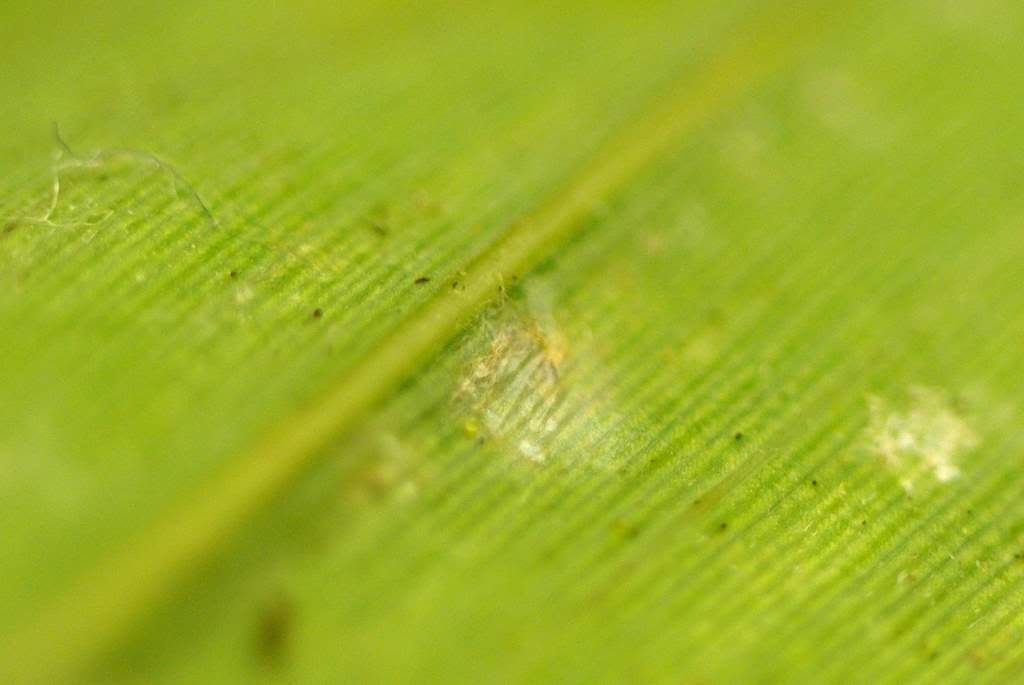For temperate bamboo growers, mites are one of the most troublesome pests. Although bamboo can host "regular" spider mites, there are certain species of mites that attack mainly bamboo (and closely related) plants: these are called "bamboo mites".
Although mites will not kill a bamboo plant, they will make its leaves look less attractive. Since this is a plant mainly grown for its looks, there is much concern about spreading of bamboo mites to uninfected plants. So much concern that many growers certify their plants as "mite free", and will quarantine new plants they receive (keep them away from any other bamboo plants) until they are inspected and/or treated for mites.
Guess what? I have mites on some of my bamboos. Are they bamboo mites, or "regular" spider mites? I just don't know yet. Photos of bamboo mite damage usually show really drastic white patches. For example, these.
The damage on my plants is much more subtle. This is one of my worst leaves:
I do appear to have the little "tents" of webs on the undersides of the leaves which is one of the characteristics of bamboo mites:
In an effort to try and positively identify these, I put them under my microscope:
Once under there I started hunting around and took photos of anything interesting (by holding my small Canon SD1000 up to the eyepiece). I used both transmissive lighting (light from the bottom, coming through the leaf):
and also reflective lighting (light from the top or side):
Both of those images are of the same two mites. You can see their webbing over them, and a couple of moulted skins (shells?). It always amazes me when I turn on the transmissive light and can see the leaf structure appear.
Here's an area with a lot more moultings:
Next I found some eggs:
The focus isn't perfect on some of these shots, as I am just holding the camera by hand right now. If I tilt it or move it slightly I get a worse image or lose the image completely, so it's touchy work.
If you've ever run your finger across the edge of a bamboo or grass leaf (or worked in bamboo with bare arms) you may have gotten tiny cuts similar to paper cuts. This is the reason:
Yikes! Those look like they could saw a finger completely off! I guess I should be grateful they just produce little cuts.
Then I found a whole "nest" of mites near the edge of the leaf:
I think it's really interesting to see the same critters in both types of lighting.
More eggs:
Okay, so now I have a good look at some of the mites on one of my bamboos (Sasaella bitchuensis). For comparison I took a leaf from a small palm houseplant I have that is infested by spider mites and put it under the microscope:
One difference you can see is that the palm leaf is not "tessellated" (broken up into rectangles) like the bamboo leaf. The other thing you can see is that the mites have damaged a lot more of this leaf.
That mite above looks very much like the mites on the bamboo, but that doesn't guarantee that they're the same species.
Here's a closeup of a couple of the mature mites and an egg from the palm leaf:
(The one on the right was moving around a lot so doesn't match up in the two photos, but the one next to the egg was stationary -- probably feeding, right?)
When magnified that much it's impossible to get the entire mite in focus at one time, as the mite is "thicker" than the focal plane of the microscope. I don't use a microscope too often so I'll have to practice at this for a while to see if I can get better images -- I'll need them for identification of the exact species of mites here I think.
(If you've got experience with microscopy, please leave me tips in the comments!)
With my uneducated eye, the mites from the two plants look to be very similar. Are they the same species, so that I don't actually have the dreaded bamboo mites on my plants? I can't tell yet.
Luckily I've found information on identifying at least one species of bamboo mite, Schizotetranychus celarius. To identify I just need to look for these characteristics:
- With 2 pair of paranal setae and 2 pairs of anal setae.
- Empodium split distally into 2 claws.
- Tarsus I with 2 pairs of closely associated duplex setae.
- Opisthosoma with 10 pairs of 'dorsal' setae
Regardless of which type of mite I have, I do want to work on controlling them. They're causing some injury to the plants (although the bamboos can shrug it off), but they make the leaves look less than ideal. So I will be posting more on this topic later this year or in the spring.
Mites on bamboo, or bamboo mites? I don't know if it really matters. In either case they have to go!


















Alan, this is a very important topic, and a very well written piece. Please post a link on BambooWeb, somebody might have the answers to your questions and/or know how to positively identify your mites.
ReplyDeleteI already have. I'll also take a look a the Spectabilis leaves in another post. I think one reason the bitchuensis has so many mites is that I didn't cut it down last year. I think if I had there would be much fewer mites.
ReplyDelete.
Also, you probably want to spray the plants I sent you with some insecticidal soap or something similar. When they're that size it's easy. =)
Alan,
ReplyDeleteGreat post on this topic. The microscopy puts it in perspective and shows the nature of the beast so speak. I wonder if shear force, like a hard spray would make a difference like what you can use to deal with the sooty mold/ant problem on the Bambusa multiplex species. I'll track this on bamboo web in the coming weeks to see what insight is provided.
Cheers! Sean
Hi! Thanks for the article, it has been very useful to know if it is really a fungi or a bugs. I'm trying to put 1/3 vinegar, 1 big spoon of biodegradable soap and water. However, I would like to know if you know for how long and how often do I need to apply it to see if it works... and most important do it works?
ReplyDeleteThanks so much for sharing Alan... finally a description as to why my bamboo leaves are splotchy... can anyone confirm if neem oil will kill them? Cheers Jill
ReplyDelete